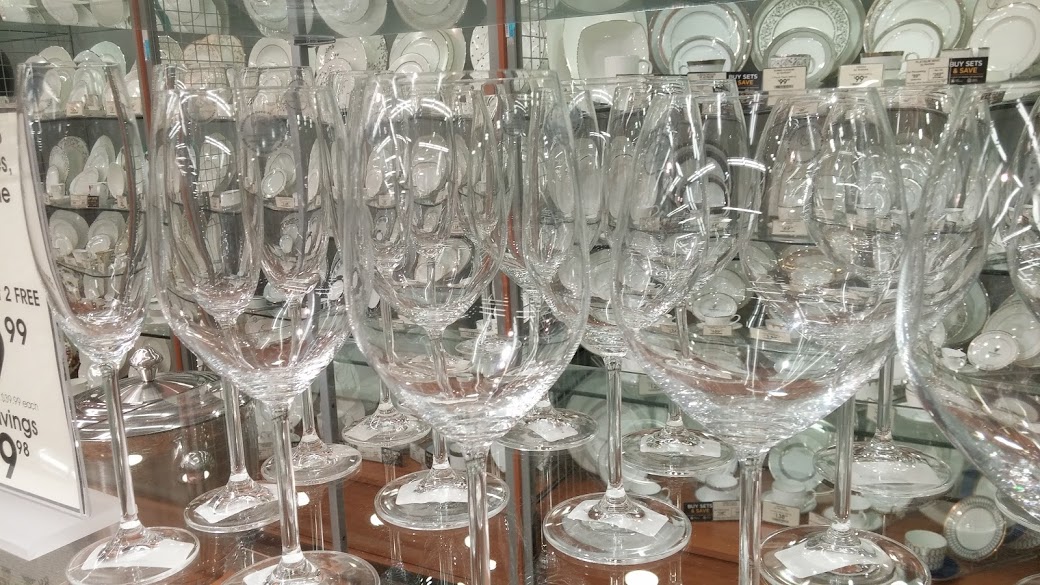I don’t drink wine straight from the bottle. It’s just not done. Between the bottle and me, there’s always a wine glass. It can be a utilitarian stemless glass bowl or elegant stemmed crystal; an average size or a giant balloon; an all-purpose style or a shape carefully designed for a specific wine. Wine glasses can be like a Ford Focus or a BMW convertible – both get you around, but the experience will be quite different.
The standard wine glass has a bowl on a stem. The bowl usually has a teardrop shape – widening out from the stem and then tapering in toward the rim at the top. The stem can be thin and fragile or thick and sturdy. Some glasses have no stem; the bowl sits right on the table, but the shape is generally the same. By the way, when I say wine glass, I’m talking about the vehicle used for drinking wine. Later, I’ll talk about the difference between the materials glass and crystal. It’s a little confusing.
Throughout history there have always been elegant wine vessels made from metal, leather, pottery, or glass. Stemmed glassware like we use today dates back to the 16th century. Generally, wine glass bowls are much larger these days. In wine drinking cultures, simple tumblers for everyday household use were more practical, less expensive, and much less fragile than stemmed glasses.
The time-honored design of foot, stem and bowl has many variations but has endured as the traditional way to enjoy wine. The bowl, perched up on its stem, is clear to show off the color and body of the wine. Its shape can concentrate and focus the aromas. In addition to elevating the wine to reflect the light, the stem lets you grab the glass without holding the bowl. The foot keeps the whole thing on an even keel. Glasses can be etched or made from cut crystal, but color should be avoided.
The wine’s aroma is captured in the bowl of the glass. Pouring wine to the widest part leaves plenty of space for air to mingle with the wine. The inward taper toward the top of the bowl focuses the fragrance to the taster’s nose. “Swirl and sniff” is an essential step in wine appreciation. Swinging the wine around the glass excites the aromas and mixes in some air to release all the subtle nuance of the bouquet. As the wine slides back down the glass the thickness of the rivulets, called legs, is an indication of the body of the wine.
The shape of the glass can have an impact on the enjoyment of the wine. The Riedel Wine Glass Company (family owned in Austria since 1756) pioneered the use of crystal and individual glass shapes designed to fine tune the tasting experience. In 1973 they introduced their groundbreaking Sommeliers series which matched glass size and bowl shape with specific wine varieties. The Sommeliers line now includes 30 different shapes for wine and a few spirits – a design for every wine style. Riedel, the dominant brand for high-end wine glasses, now offers nine more series in addition to Sommeliers for almost limitless style choices. riedel.com
At a dinner party a few years back, I was assured that the shape of wine glasses was modeled after the curve of a ship’s hull. Although there can be similarities between some glasses and some boats, I can’t find anything that backs this up. They seem to have developed their similarities independently. On the other hand, some elegant boats are said to have a wineglass stern – where the curvy lines of the transom mimic the bowl of a wine glass and taper down to the keel which stands in for the stem.
There’s no doubt that wine glass shape and size have an impact on tasting, but you probably don’t need all 30 styles. These glasses are elegant, stylish, and beautiful – but they’re also expensive. A set of 8 entry level Riedel Vinum Cabernet glasses is $150 at Bed, Bath, and Beyond – just under $20 each. If you want to have a couple different styles for whites and reds, it can get expensive – never mind the storage.
Crystal is lighter and stronger than glass. Traditionally made with lead (at least 24%), crystal glasses have a characteristic ring when tapped and can be made into thinner, more elegant shapes. Using crystal glasses adds pizzaz to a wine experience. On the other hand glass, made with sand, is durable, practical, and inexpensive, although not as strong as crystal.
For everyday drinking I usually use glass. It may not be as thin and elegant, but a set of 12 is about the same price as one crystal glass. I like to use stemless glasses. They are practical, sturdy, and easily fit in the dishwasher. Our crystal comes out for better wines and special occasions. My feeling is that the price of the bottle and the price of the glass should correlate. Putting your $10 Merlot in a $20 glass probably won’t change the wine experience. On the other hand, a pricier Napa Cab or Chardonnay from Burgundy deserves the best, most elegant, and most wine-friendly presentation available.
There’s overwhelming choice in wine options, including shape, size, glass or crystal, and stem or not. I like to have some choice depending on the wine; it’s part of the fun. But Focus or Beemer, it’s still only a vehicle for what’s in the glass.

















No Comment